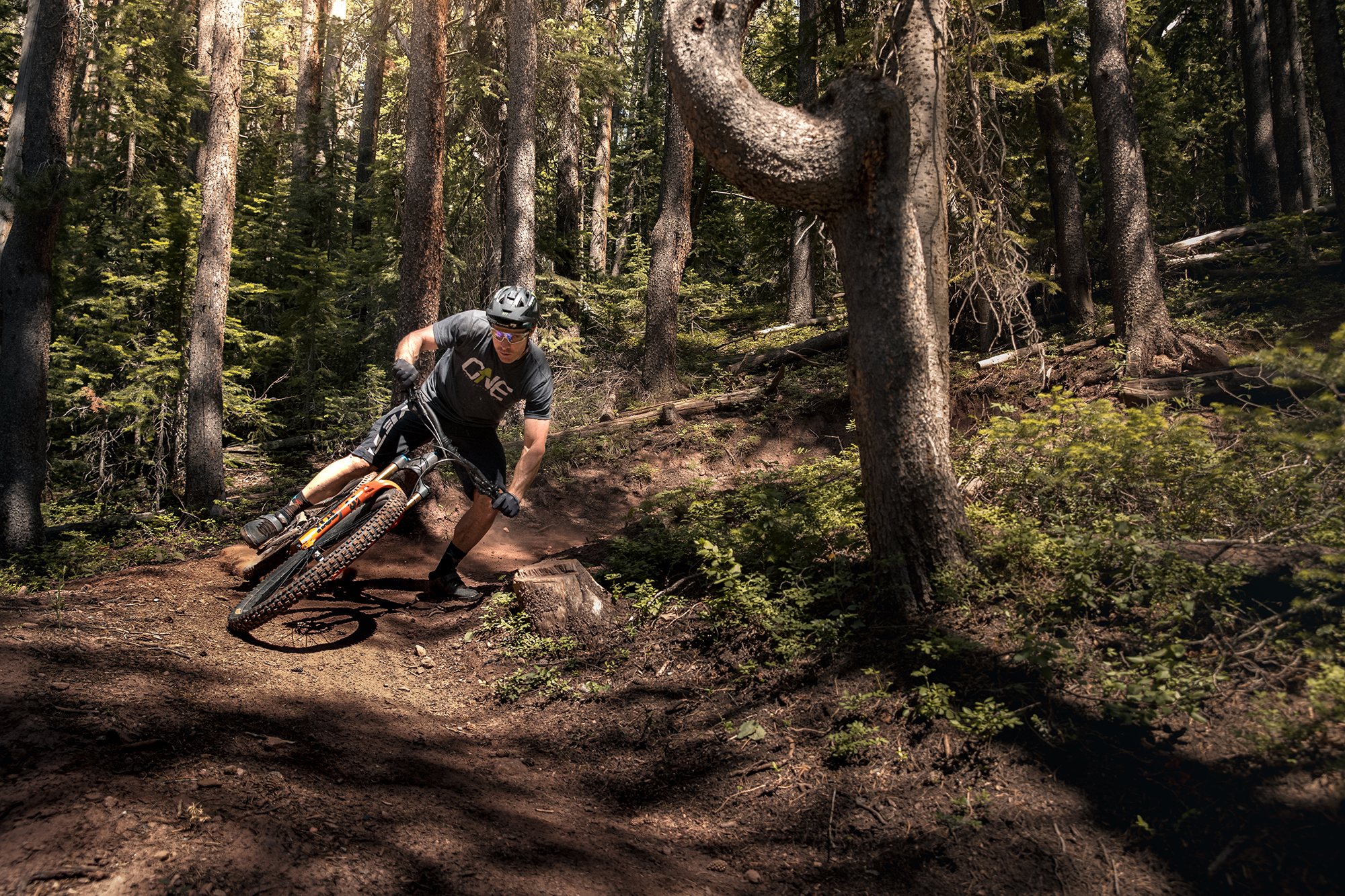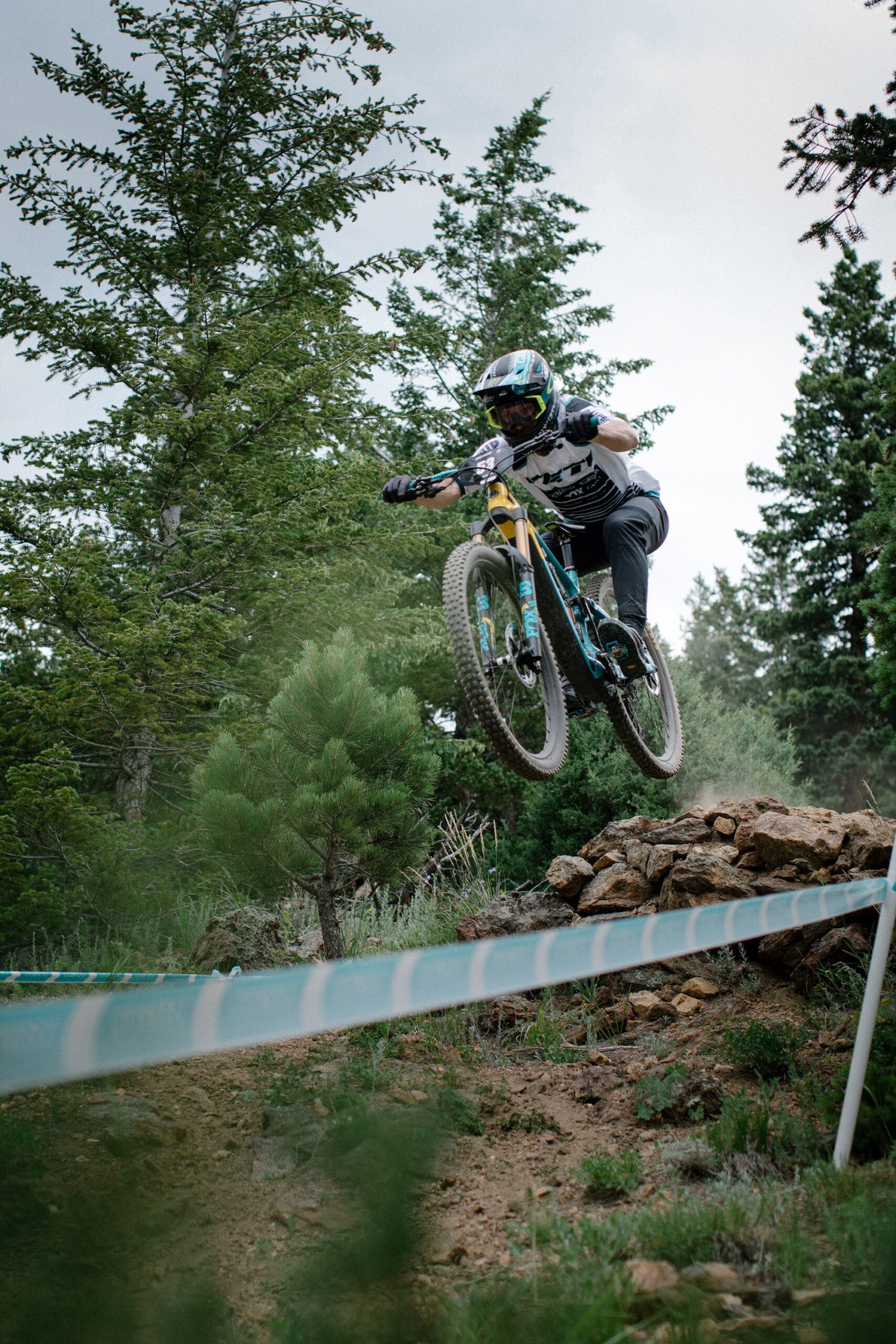Earlier this year the internet lit up with conspiracy theorists going crazy when a single photo emerged of a rather different looking prototype Yeti being riding out in the wild…
While it was blurry, dark and at a questionable angle, it appeared to be a new, never seen before species. This new breed seemed to have updated anatomy, including a different rear end, redesigned limbs and an enhanced speed up the hills. Yes, we are talking about the new Yeti 160E.
The bike marks the first entry into the lucrative e-MTB market from this historic brand. And in fact, they’re pretty much the last of the major mainsteam brands to make the dive (come on Transition – pull your f*king finger out and join the party already!) The 160E comes as you would expect dressed in that beautiful turquoise paint, and the bike retains Yeti’s historic smooth lines and that classic silhouette.
The evolution of man took hundreds of thousands of years, but, thankfully, this Yeti was a little faster. With a deep race heritage, the 160E was built from the ground up with one objective in mind, to go fast. It wasn’t all done overnight either; 26 custom moulds, 6 test mules with 5 years of development and 1 new suspension system, this bike is coming out of the gate swinging.
If Yeti wanted to keep their switch infinity link and have a motor, the rear end was going to be way too long. Instead of bashing their head against a wall trying to make it work, they threw it all in the bin and redesigned the whole dame thing. In classic Yeti fashion, they didn’t take the easy route of four-bar, faux bar or high single pivot either.
 Like every good bachelor party, Yeti decided that it needed at least six bars to work. While from the outside, it may look like your everyday four-bar suspension linkage, it is the small rocker link by the motor and the bar that joins it to the top rocker where the magic lies. As the rear wheel moves up in the first half of travel, the smaller rocker also moves up. Once it gets deep into the travel, past the inflection point, the lower link moves downwards.
Like every good bachelor party, Yeti decided that it needed at least six bars to work. While from the outside, it may look like your everyday four-bar suspension linkage, it is the small rocker link by the motor and the bar that joins it to the top rocker where the magic lies. As the rear wheel moves up in the first half of travel, the smaller rocker also moves up. Once it gets deep into the travel, past the inflection point, the lower link moves downwards.
The switch at the inflection point not only controls the wheel path but allows Yeti to optimise both anti-squat and anti-rise in a unique curve for the 160E. Because E-Bikes exert different forces through the drivetrain in a more consistent style, the standard kinematics wouldn’t be optimal.
Anti-squat remains very similar across the range of gears throughout the travel as E-Bikes use more of the gear range while climbing instead of sitting in the two easiest gears. As the bike gets deeper into the travel and past the inflection point, the 160E’s anti-squat dives into the negatives, leaving any rider with plush active suspension as they bomb through gnarly tracks. This lower anti-squat also relieves any pedal kickback issues, so you can attack with composure.
The anti-rise figures barely change throughout the travel so riders can have a predictable ride. Yeti employed a much lower anti-rise rate so the bike could manage the extra weight effectively on the trails. The 160E will stay poised for attack without any geometry changes, pitching forward or loss of traction. It is one damn tame animal.
Just as you think there couldn’t possibly be any more tricks in this suspension design, the Yeti engineers pulled another trick out of their bag. “Flip-chip” seems to be the catchphrase that sums up bikes in 2021. While most other flip-chips are employed to change a bike’s geometry, the 160E moves the lower shock mounting position to alter the progression of the bike. Depending on the position, you have the option to run a 25%, 30% or 35% progressivity in the rear. The 25% position will give you a more supportive, direct and efficient feeling bike. The 30% (stock) position balances plushness with efficiency for an excellent all-around feel. While the 35% progression will give you the ultimate plushness off the top with a progressive pop at the end, ideal for a coil shock.
All three leverage curves are linear and remain predictable throughout the travel. With only a 2 mm difference in travel between each setting (159-161-163) and no change in the anti-squat or the anti-rise figures, any rider can find their ideal ride feel with no drawbacks.
Every main pivot uses floating collet axles and pinch bolts to ensure correct tolerances throughout the linkages. Accurate tolerances don’t just guarantee the rear end moves smoothly without resistance but extend bearing life.
The frame is only available in carbon, and we would expect nothing less from this premium brand. Yeti uses its top-level TURQ series carbon to provide the best balance of a light bike with the stiffness required. Whoever designs these bikes have nailed the lines and visuals of the 160E frame. It has to be one of the best looking E-Bikes on the market.
 Internally routed cables can be the bane of a mechanics existence while also becoming one of the most prominent noise sources when done wrong. It is made easy thanks to the cable management tray located between the battery and the frame. All you have to do is remove the battery using a 4mm Allen key, and you have access to the entire loom with ease. Tube in tube guides in the rear triangle makes routing a breeze.
Internally routed cables can be the bane of a mechanics existence while also becoming one of the most prominent noise sources when done wrong. It is made easy thanks to the cable management tray located between the battery and the frame. All you have to do is remove the battery using a 4mm Allen key, and you have access to the entire loom with ease. Tube in tube guides in the rear triangle makes routing a breeze.
When the cables exit the frame and become visible, the 160E uses very intelligent guides to reduce slaps or rattles. Every cable is clamped using a modular guide and sent right where it needs to go. Even the ONEUP guide has a custom touch to divert the rear mech cable over the top of the chainring into the chainstay. It is the small touches like this that really make these high-end bikes worth every cent.
All this tech goes out the window if the geometry is quirky and the bike rides like a bag of marbles. Thankfully after years of development, the 160E seems Dialled, even with one odd geometry number. The 64.5-degree head angle, 78-degree seat angle and 446mm chainstays are all pretty much bang on for a modern shred sled. Yeti controversially raised the BB height to 350mm, and it may have you scratching your head but, it makes sense. Raising the BB counteracts the weight of the motor and battery to maintain a lively feel.
The 160E is available in two build kit options, the C1 and the T1. They both use the high-end TURQ carbon frames, the SIXFINITY linkage and in house tuned Fox X2 shocks. Yeah, you read that right; Yeti has their own in-house shock tuning operation that ensures all bikes are fitted with the perfect shock to suit the kinematics. This level of attention is really genuinely next level.
Continuing the customisation theme, the 160E uses the Shimano EP8 motor to assist riders in conquering any climb on either model. The EP8 motor is not just reliable, powerful and packs a punch when it comes to torque but, it is very tuneable through the app. You can tweak the power settings in each mode to uniquely suit your riding style.
Yeti have taken the opportunity to turn another dial to 11 when it comes to their in house E-Bike specific bars. Using a thermoplastic moulding technique, they were able to dampen highspeed vibrations while increasing strength where it is needed most. Thanks to the increased accuracy of this manufacturing process, holes were placed in the bars for internal routing.
The C1 comes fitted with The C1 build kit is highlighted by an E-tuned FOX 38 Performance Elite fork, FOX Float Performance X2 shock, DT Swiss E1900 wheels, Shimano SLX drivetrain, SRAM Code R brakes, OneUp dropper, 2.5-inch Maxxis Assegai EXO+ MaxxTerra front tire, 2.4-inch Maxxis DHR II Double Down rear tire and a OneUp chain guide.
The T1 is fitted with E-tuned FOX 38 Factory Grip 2 fork, FOX Factory Float X2 shock, DT Swiss E1700 wheels, Shimano XT drivetrain, Shimano XTR cranks, SRAM Code RSC brakes, RockShox AXS Reverb dropper, 2.5-inch Maxxis Assegai EXO+ MaxxTerra front tire, 2.4-inch Maxxis DHR II Double Down rear tire and a OneUp chain guide.
While reading this article, I know what you have been thinking all along. Do you need to sell a kidney, liver, arm or your first 3 children to afford one of these immaculate beauties? In a world where a $20,000+ bike is not abnormal, the 160E is priced fairly reasonably. The C1 spec level can be yours for $15,990, while the T1 is $19,990.
The 160E is the pinnacle of engineering, and it pushes boundaries in every aspect of design. Each feature is just as practical as it is attractive while remaining void of unnecessary marketing jargon. The product designers built this Yeti this bike from a myth into a legend. We can’t wait to spot one in the wild. [R]







